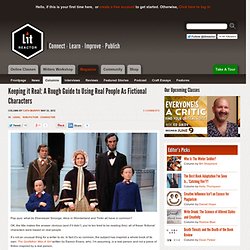

Personality Types. Untitled. How to Write a Character From Start to Finish. The best fiction is about a character who changes in some significant way.

The selfish brute learns to put others first. The woman marrying for money decides to marry for love. The career ladder climber learns to cut back on his hours to enjoy his family. The bitter old crone learns to let others in. The independent pilot of the Millennium Falcon learns to care about a cause. We love to see characters transformed. —by Jeff Gerke Most of the time, main characters in fiction are changing for the better. But there’s also room for characters who change for the worse. Perhaps most intriguing of all is a “bad” character who flirts for a while with the idea of being good, but then decides that his true self is on the dark side of the street. Of course, not every story has to be about a character who changes. Whether your protagonist ultimately turns toward or away from the light will be up to you, but we’ll look at ways to send her on a journey in which she’s transformed.
The Inner Journey.
Character is the very life of fiction. Setting... 25 Things You Should Know About Character. Previous iterations of the “25 Things” series: 25 Things Every Writer Should Know 25 Things You Should Know About Storytelling And now… Here you’ll find the many things I believe — at this moment!

— about characters: 1. Without character, you have nothing. 2. A great character can be the line between narrative life and story death. 3. Don’t believe that all those other aspects are separate from the character. 4. The audience will do anything to spend time with a great character. 25 Things You Should Know About Character. Anne Tyler’s Tips on Writing Strong (yet Flawed) Characters. Anne Tyler belongs to a disappearing generation of writers, those who came into their own in an era when it was more than enough to—well, to simply write.

Intensely protective of her craft, she hasn’t given an in-person interview or participated in a book tour since 1977. In an age where writers are expected to lead double lives as self-promoters to enjoy any semblance of commercial success, Tyler carries on just as she always has, remaining steadfast in her singular devotion to her writing process. And she can get away with it, too, because she’s Anne Tyler—and she’s just that indisputably good. If Tyler’s writing career sounds like a luxury, a lofty dream come to life—penning a well-received book every few years in the quiet of her home in Baltimore, eschewing the media in favor of the companionship of her characters—it’s one she’s earned.
Her books are about families, and the complications therein—marital discourse, sibling rivalry, resentment and, underneath it all, love. Character Chart for Fiction Writers - EpiGuide.com - StumbleUpon. If you're a fiction writer -- whether you're working on a novel, short story, screenplay, television series, play, web series, webserial, or blog-based fiction -- your characters should come alive for your reader or audience. The highly detailed chart below will help writers develop fictional characters who are believable, captivating, and unique. Print this page to complete the form for each main character you create.
IMPORTANT: Note that all fields are optional and should be used simply as a guide; character charts should inspire you to think about your character in new ways, rather than constrain your writing. Fill in only as much info as you choose. Have fun getting to know your character! If this character chart is helpful, please let us know! Looking for more character questionnaires / charts? Keeping it Real: A Rough Guide to Using Real People As Fictional Characters. Pop quiz: what do Ebeneezer Scrooge, Alice in Wonderland and Tintin all have in common?

OK, the title makes the answer obvious (and if it didn’t, you’re too tired to be reading this): all of these ‘fictional’ characters were based on real people. It’s not an unusual thing for a writer to do. In fact it’s so common, the subject has inspired a whole book of its own: The Godfather Was A Girl written by Eamon Evans, who, I’m assuming, is a real person and not a piece of fiction inspired by a real person. But let’s not get reductive.